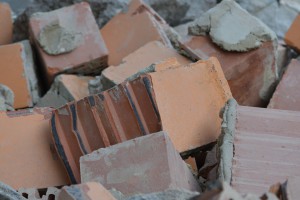Pre-demolition audit
Contents |
[edit] Definition
The document "Building Blocks; a manifesto to transform the Built Environment" published by Architects Declare defines a pre-demolition audit as
"a survey carried out by qualified personnel to determine the quantity of material in a building before its demolition or deconstruction. It helps to identify materials within the building that could be reused or repurposed."
[edit] Introduction
It’s always best, when considering demolishing a building, to ask certain questions before beginning any work – even planning work. The first, and perhaps the biggest, is to ask why you want to demolish the existing site – can it be redeveloped or can elements of the site be kept?
A pre-demolition audit can help answer these questions, along with assessing the materials within the buildings and their potential value. When you have all of this information, that’s when you need to look at whether to refurbish, renovate or demolish.
[edit] So, you have decided to demolish
What will you be doing with all of those materials? Best practice says you should try to reclaim as much waste as possible, and there are four key ways to handle demolition waste reclamation, known as the Four R’s – each with their own advantages:
[edit] Reduce
Are there any areas of the building you can keep? Reducing the amount of waste through not demolishing a part of a building will help you to save time and money through sorting or transportation.
[edit] Reuse
What areas can be reused in their current form? Timber or metal beams, intact fireplaces, heating or electrical systems? If these, and more, can be reused in the new building on the same site, this will help you save on some new build materials cost and will reduce time spent recycling or disposing of materials, saving time in the process.
[edit] Recycle
When materials on your site can’t be reused, can they be recycled? This is taking the materials and using them in a different form, for example taking a timber beam and shredding this, to reform into MDF or a similar material – for use in the new building.
[edit] Recover
This option is often best for teams that aren’t able to go through options 1-3, for example if there’s little time to complete these activities. Recovering materials in essence a means to send all mixed (unsorted) waste materials to a facility, where they will look to reuse or recycle them externally.
The more material that can be dealt with using a mixture of the above options, the greater the chance of saving money through on build costs, selling materials that have been identified as having value, or even just avoiding landfill tax.
This article was created by --BRE Buzz. It was originally published on BRE Buzz in March 2016 and was written by Jo Goodwin, Marketing Manager for BRE SMARTWaste and BRE YellowJacket.
You can see the original article here.
Read more BRE Buzz articles here.
[edit] Related articles on Designing Buildings
- Building Research Establishment.
- BRE articles.
- BRE Trust.
- BREEAM.
- Decommissioning.
- Demolition.
- Design for deconstruction – helping construction unlock the benefits of the circular economy.
- End of life potential.
- Explosives.
- How to conduct a pre-demolition audit.
- Pre-construction information.
- Quantification of construction materials in existing buildings (material intensity).
- Recycling.
- Site waste management plan.
- Sustainable materials.
Featured articles and news
One of the most impressive Victorian architects. Book review.
RTPI leader to become new CIOB Chief Executive Officer
Dr Victoria Hills MRTPI, FICE to take over after Caroline Gumble’s departure.
Social and affordable housing, a long term plan for delivery
The “Delivering a Decade of Renewal for Social and Affordable Housing” strategy sets out future path.
A change to adoptive architecture
Effects of global weather warming on architectural detailing, material choice and human interaction.
The proposed publicly owned and backed subsidiary of Homes England, to facilitate new homes.
How big is the problem and what can we do to mitigate the effects?
Overheating guidance and tools for building designers
A number of cool guides to help with the heat.
The UK's Modern Industrial Strategy: A 10 year plan
Previous consultation criticism, current key elements and general support with some persisting reservations.
Building Safety Regulator reforms
New roles, new staff and a new fast track service pave the way for a single construction regulator.
Architectural Technologist CPDs and Communications
CIAT CPD… and how you can do it!
Cooling centres and cool spaces
Managing extreme heat in cities by directing the public to places for heat stress relief and water sources.
Winter gardens: A brief history and warm variations
Extending the season with glass in different forms and terms.
Restoring Great Yarmouth's Winter Gardens
Transforming one of the least sustainable constructions imaginable.
Construction Skills Mission Board launch sector drive
Newly formed government and industry collaboration set strategy for recruiting an additional 100,000 construction workers a year.
New Architects Code comes into effect in September 2025
ARB Architects Code of Conduct and Practice available with ongoing consultation regarding guidance.
Welsh Skills Body (Medr) launches ambitious plan
The new skills body brings together funding and regulation of tertiary education and research for the devolved nation.
Paul Gandy FCIOB announced as next CIOB President
Former Tilbury Douglas CEO takes helm.
























